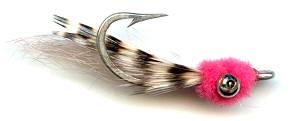Pink and Tan Mini Puff Bonefish Saltwater Fly
The Mini puff is a long time favorite fly used all over the world. It is great for spooky shallow water bonefish tailers! It was first tied by Capt. Neil Bohannon in the 70's and is still one of the best for shallow flats and nervous fish. It is lightly dressed for a soft presentation in skinny water. It lands like a feather, sinks slowly. The perfect skinny water fly.

MINI PUFF INVERTED HOOK PATTERNS. Hook size 6 & 4 - $US each
This fly is an inverted hook pattern. It is designed so that the hook rides above the shank in the water. The idea is that the hook does not get caught on the bottom. By adding a relatively stiff wing material near the hook eye which covers the hook point, the fly becomes nearly weedless. If tied with sparse materials these flies can be made to sink very fast. This fly will bounce up and down on the retrieve and makes puffy little clouds on the bottom that sends out visible signals to nearby fish who interpret it as, ‘there is something moving down there that maybe good to eat. In nature if you can be seen your dead. Most prey species of the bonefish are very well camouflaged. Your fly must not mimic nature to well for if it cannot be seen you will not catch fish.
Because the Mini Puff fly rides hook up it consequently does not gill hook many fish unlike the conventional hook down fly. Although the fly was not designed with this feature in mind it has increased the amount of fish that can be caught and released. In nature if you can be seen your dead. Subtle colored flies work best on sunny, bright days in shallow water. Bright colored flies work best on cloudy days in deeper water or at sunset. Bonefish patterns should match the color of the bottom in the area you are fishing: light colored flies on light sandy bottoms and dark colored flies on dark turtle grass/coral bottoms. Flies that hit the water with little impact are more effective than those that strike heavy and spook the fish.
Bonefish know that if they reach the crest of a flat on an incoming tide they will find the best food waiting for them. Look at your tide tables and find the crest. Sometimes schools of Bonefish will rush towards there as the tide turns and starts to flood. Getting a take is all about placement and delivery in front of your target.. Sometimes it does not matter if your fly is tan or orange.
On my last trip my guide spotted a single Bonefish grubbing in the mud about 50 feet from the boat in perhaps 18 inches of water. I managed to get a perfect cast to it, started retrieving and felt the line tighten as the the fish took. The normal advice at this point is to keep retrieving, not strike, as the the fish will generally hook itself. it worked. For a couple of seconds the fish jut shook it's head, not knowing what had happened to it. then it took of in a flash. these fish are really fast. In seconds all the fly line and half the backing had gone from the reel. I eventually landed a nice 6lb bonefish.
With a slow moving fish I have been able to get a a bite by casting behind the tail (admittedly the first time I did this was by mistake and a short cast). I noticed the fish visible change directions as it heard the plop of the fly. It must have thought that some thing was alive behind it and trying to escape. It wheeled around and went to investigate. It saw the puffs of sand as I retrieved and it attacked. It does not always work but is a good last resort option that has claimed a number of bonefish.

